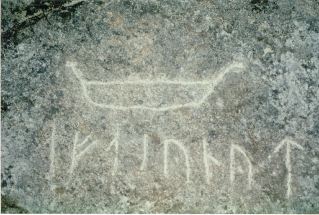 Den första runristningen i Vörå, den s.k.
Höjsal-ristningen,
Den första runristningen i Vörå, den s.k.
Höjsal-ristningen,
upptäcktes av bonden Hugo Berg på midsommardagen 1978.
Ristningen består av en båtbild och under den en kort och tydlig
runristning med åtta runtecken.
Det skulle ta tjugo år efter upptäckten, innan den korta inskriften
fick en godtagbar tydning.
Detta skedde på ett runseminarium i Vörå sönd. den 14 juni
1998,
där docent Evert Salberger från Göteborg på ett övertygande sätt
visade att Höjsal-ristningen,
som saknar ordskillnadstecken, bör uppdelas och läsas ”aft
sun nut” med dubbelläsning av n-runan.
Tydningen blir då ”Efter/till minne av den dugande/duktiga
sonen”.
Läsningen och tydningen av Vörå-runorna baserar sig på en
omfattande forskning gjord av runologen, docent Evert
Salberger.
60 meter västerut finns en stor
stensamling, som antas vara en båtform.
Samlingen har halvrunda sidor och spetsig i båda ändorna, och är
cirka 100 gånger 30 meter.

 The first runic inscription in Vörå, the so-called
Höjsalristningen,
The first runic inscription in Vörå, the so-called
Höjsalristningen,
was discovered by the farmer Hugo Berg on Midsummer Day in
1978.
The inscription consists of a picture of a boat and under that
a
short but clear runic inscription consisting of eight runic
characters.
It would take twenty years after the discovery until the short
inscription got an acceptable interpretation.
This took place at a runic seminar in Vörå on June 4th
1998,
where docent Evert Salberger from Gothenburg in a convincing way
showed that the Höjsal inscription,
should be divided and read “aft sun nut”. The
interpretation then becomes “In memory of the capable
son”.
The reading and interpretation of the Vörå runes are based on
extensive research done by the runologist and docent Evert
Salberger.
60 metres to the west is a big pile of stones, which is
supposed to be a boat mould.
The pile has semicircular sides and is pointed in both ends, and is
about 100 x 30 metres.